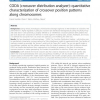Free Online Productivity Tools
i2Speak
i2Symbol
i2OCR
iTex2Img
iWeb2Print
iWeb2Shot
i2Type
iPdf2Split
iPdf2Merge
i2Bopomofo
i2Arabic
i2Style
i2Image
i2PDF
iLatex2Rtf
Sci2ools
101
click to vote
BMCBI
2011
2011
CODA (CrossOver Distribution Analyzer): quantitative characterization of crossover position patterns along chromosomes
Background: During meiosis, homologous chromosomes exchange segments via the formation of crossovers. This phenomenon is highly regulated; in particular, crossovers are distributed heterogeneously along the physical map and rarely arise in close proximity, a property referred to as “interference”. Crossover positions form patterns that give clues about how crossovers are formed. In several organisms including yeast, tomato, Arabidopsis, and mouse, it is believed that crossovers form via at least two pathways, one interfering, the other not. Results: We have developed a software package - “CODA”, for CrossOver Distribution Analyzer - which allows one to quantitatively characterize crossover patterns by fitting interference models to experimental data. Two families of interfering models are provided: the “gamma” model and the “beam-film” model. The user can specify single or two-pathways modeling, and the software package infers the model’s parameters and their confide...
Artificial Intelligence | BMCBI 2011 | Coda | Crossover | Model |
| Added | 12 May 2011 |
| Updated | 12 May 2011 |
| Type | Journal |
| Year | 2011 |
| Where | BMCBI |
| Authors | Franck Gauthier, Olivier C. Martin, Matthieu Falque |
Comments (0)

